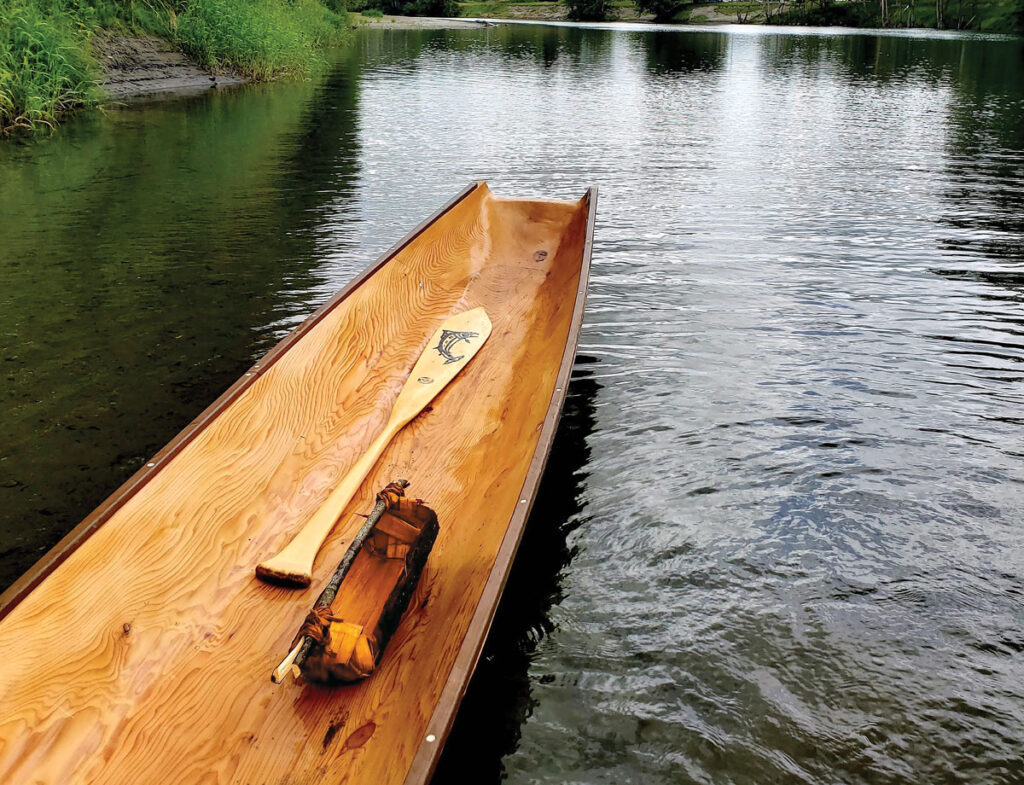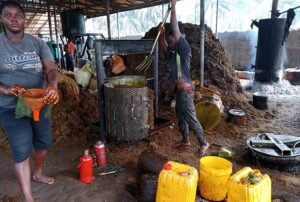
Click here to download this article as it appears in the magazine, with accompanying artwork.
Editors’ note: This article is from the Fall 2022 issue of the Nonprofit Quarterly, “The Face of Climate Change.”
Oftentimes, when people think about the Pacific Northwest and the Salish Sea, they think of lush evergreen rainforests. They think of verdant ferns and dew-covered mosses, grand western red cedar trees, and broad leaf maples. However, there is an archipelago within the Salish Sea, a group of islands in the rain shadow of the Olympic Mountains, that receives just half of the precipitation of Seattle. Today, these islands are known as the San Juan and Gulf Islands. They are very dry: native cacti grow on the rocky bluffs, and many of the beaches have windy sand dunes. The ecosystems are so diverse that you can walk from a snow-covered mountain to a cactus-covered bluff in a single afternoon. It is here that my ancestors discovered how they could play a pivotal role in maintaining these bountiful, naturally productive gardens with one simple tool: fire.
An ancient permaculture concept has existed in Middle and North America for thousands of years that uses companion planting of three crops that form a symbiotic relationship. Many people know these as the “Three Sisters”: maize, climbing beans, and squash. The cornstalks provide a trellis for the beans, the beans strengthen the cornstalks and fix nitrogen into the soil, and the squash ward off weeds and pests. In the Americas, this system may have been in practice for 3,500 years or more.1
There is, however, a lesser-known “companion planting” permaculture practice in the Pacific Northwest Salish Sea in Native America—a Coast Salish version of the Three Sisters that expands across ecological zones from terrestrial prairies to the nearshore aquatic. Three of the main food staples, Garry oak, camas, and salmon, were all managed with fire ignited by traditional Coast Salish people—that is, until incoming settlers upended the traditional management practices.
Fires have been suppressed in the Pacific Northwest since settler “establishment” of American territory.2 Oregon Territory was established in 1848, which included the area we now know as Washington State. The Treaty of Point Elliot was signed in 1855 and ratified in 1859, with tribes being relocated to minuscule reservations. In the 1860s, there was a smallpox epidemic that decimated Coast Salish communities. And by the 1870s, the remaining longhouses in traditional locations were being destroyed by American settlers.3
Nowadays, houses sprawl across the landscape—both along the waterfront and in the forested uplands. In traditional times, there were no houses in the forests or hills of the islands that would be at risk from a wildfire—people lived along the beaches. Now, there are million-dollar retirement mansions in the middle of forests of what may as well be matchsticks. There is also industry incentive to “protect” forests from fire in order to preserve the harvestable timber. There is very little fire risk management other than the suppression of all wildfires—which actually increases the risk from wildfire due to buildup of fallen branches and other natural debris on the forest floor. And, if anyone wants to perform a controlled burn for cultural or ecological reasons, an enormous pile of permits is required. Further complicating the picture, land on these relatively small islands tends to be owned and managed by a mix of federal, state, county, and private or nonprofit entities. It is politically challenging to manage lands on an ecosystem-wide level when there can be a dozen stakeholders involved. All of these complications have led to a severe loss in habitat and endangerment of the Coast Salish Three Sisters.
Garry Oak, Camas, and Salmon
The Garry oak produces acorns that are easily stored for long periods of time and are edible after processing. They produce a coarse flour that can be added to soups or mixed into pemmican along with cured meats and dried berries. The oak flour can also be blended with cattail root flour, which contains gluten, and cooked into a bannock. The acorns have a nutrient profile that includes fat, protein, and carbohydrate.
Historically, fire supported the life cycle of the Garry oak. Not only did it eliminate the taller conifers that could overshadow it but it also appeared to encourage the acorns to sprout. And even if the top of the tree was killed by the fire, its roots could send up new sprouts.4 The fires would burn up the coniferous trees, but Garry oak trees are fire-adapted to withstand the heat, so they remained.5 This created a sort of oak savanna similar to those in the Midwest.
Historically, fire supported the life cycle of the Garry oak. Not only did it eliminate the taller conifers that could overshadow it but it also appeared to encourage the acorns to sprout. And even if the top of the tree was killed by the fire, its roots could send up new sprouts.
The wood of this oak tree is valuable, too: the traditional name, cheng’ilhch (chung-eel-ch), translates to D-adze tree, referring to the traditional carving tool’s handle made from it, and the wood is also used for making tools that are used to dig the camas that grows in the same ecosystem—one of the many important native food and medicine plants that grow in the prairies on these rain shadow islands. Camas is a purple flowering bulb whose ranges extend from British Columbia to California to Montana and Wyoming. Many tribes have used it as a food source because it is delicious.
Although camas isn’t in common usage nowadays, it exemplifies the principles of the slow food movement. The seeds take four to five years to become a mature bulb, and the bulbs take twenty-four to thirty-six hours to cook in a traditional earthen steam oven. Early explorers in the Pacific Northwest, when first encountering the flowering purple fields of camas, mistook them for a purple lake because the flowers were so abundant. The cooked and processed camas was preserved for winter storage and for trade. It was also ground into a flour and used to sweeten soups and other foods.6
Controlled burns across the landscape maintained open prairie habitat for the camas flowers to thrive. Now, the forest edge is encroaching on the open spaces where Douglas fir trees quickly overshadow the relatively short Garry oak trees. The invasive pasture grasses, introduced as fodder for sheep and cows, are now forming thick sod with tall grasses that choke out the native camas flowers. There has been a 91 percent loss of Pacific Northwest prairies, with only 3 percent that are productive with native species.7
Today, many of the Coast Salish tribes are rekindling their relationship with these plants. Talking to tribal elders about camas fields is like hearing about a mythical plant from storied times that nobody has tasted in over a century. Small groups within a few tribal communities, however, are bringing these delicious plants back. Because camas bulbs take such a long time to cook and can be tedious to harvest (especially in an untended prairie), it is a labor of love. Some people use crock pots to slow-cook the camas, but the traditional cooking method is to heat rocks with fire in a 3′ x 3′ x 3′ hole in the ground, then bury the clean camas bulbs in a bundle of plants and steam them in the earth for twenty-four to thirty-six hours. This method is far superior to Crock-Pot cooking, because it imparts an earthy/smoky flavor to the caramelized starches of the bulb.
One example of a group that is practicing these traditional pit-bakes is the Coast Salish Youth Stewardship Corps, an intertribal group comprising youth from up to seven or more tribes with ancestral ties to the San Juan Islands, many of whom have not seen camas practices in their families for three generations or longer.8 This group is aiming to put traditional ecological knowledge into practice toward habitat enhancement and environmental stewardship, and has performed four annual camas bakes to date to feed tribal youth and elders.
While the relationship with camas and Garry oak did fall out of practice, most tribes never stopped fishing—and salmon, one of the most important food sources in the entire delicatessen of Coast Salish culture, is highly revered as being a sacred gift to the people. There are countless methods to fish for, cook, and prepare salmon. It is mind-boggling how many different technologies were developed for one fish with the simple materials of wood, bone, and stone.9 Sometimes regarded as one of the healthiest meats, this fish has sustained millennia of Coast Salish people, who recognized its importance. It is honored in legends that are thousands of years old, many of which have management techniques encoded within them.
Tribal elders speak of how the fires also had a positive impact on the nearshore aquatic habitat, from its use as an aid to carving out large dugout cedar canoes to promoting salmon runs through the islands.
Some of these stories mention that a certain medicinal plant, when burned on the shore, would send a smell into the water and call the salmon back home. It helped the fish to navigate from the open ocean to return into the Salish Sea. This is a very old legend that science has recently backed up; we are aware that fish use a combination of an internal geomagnetism to get themselves close to their home stream and then scent-memory to ascertain the exact location of their birthplace.10 They miraculously find their home stream after traveling thousands of miles. Fires can also create complexity in river systems and nearshore marshes that is beneficial for fish, such as when trees fall into the water and create diverse habitats.11
Sign up for our free newsletters
Subscribe to NPQ's newsletters to have our top stories delivered directly to your inbox.
By signing up, you agree to our privacy policy and terms of use, and to receive messages from NPQ and our partners.
Tribal elders speak of how the fires also had a positive impact on the nearshore aquatic habitat, from its use as an aid to carving out large dugout cedar canoes to promoting salmon runs through the islands by sending nutrients from the ash to eelgrass beds and attracting the fish by its scent. Smoke cover also cooled the water temperature in the heat of the summer, making the water more habitable for fish.12
Many of these lessons are learned from the “Salmon Boy” story, a legend shared by many Coast Salish people. It is about a young boy playing by a river who got swallowed whole by a large salmon. This fish took the boy down into the deep salt water, where there was a salmon village, complete with salmon longhouses with fires. The boy lived with the salmon long enough to learn their culture and what they needed to continue to flourish, which became the people’s creed of responsibility of stewardship after the boy returned home and told the people of all he had learned.
Today, tribes still recognize and celebrate this story annually to honor the salmon and our commitment to stewarding the waters, often working to reverse the damage from the last one hundred and fifty years of settler sprawl and overtaking of land management, when tribes were removed from most of their traditional territory and placed on small reservations.
Another ancient story, the legend of Qwu7qwe7elwut (kwoh-kwol-uh-woot), describes the marriage between the land, the sea, and the Coast Salish people from the Samish Tribe. It tells of a young maiden who caught the eye of the god of the sea. He wanted her hand in marriage, but the maiden’s father refused to let his daughter marry him and live underwater. So, the god of the sea took away all the water and all the seafood, and the people suffered. Eventually, the father gave in and allowed them to marry but only so long as it was promised that she would return home to visit each year. Eventually, Qwu7qwe7elwut became adapted to the sea and uncomfortable on land, so she doesn’t visit anymore. But we do see her kelp-forest hair in the waters of Deception Pass.
The sea has gifted the Samish people with bountiful foods from the water ever since. This is an abbreviated version of the legend, but it gives you an idea of how deep the connection among people, land, and water is for the traditional Coast Salish people. They viewed themselves as literally married to the sea, with their most beautiful maiden sacrificing herself to the sea in order to provide for the future generations. We see how there was an understanding that the management of the land and the management of the sea have an impact on each other, and that there is a connection among all the resources with which we live.
The importance of these three food staples cannot be overstated. All three could be preserved for winter use, when traveling by canoe was not possible and it was crucial to have enough food stores to make it through the dormant season. They were critical for trade—which I’ve heard my Coast Salish elders refer to as “Indian Insurance.” Although, it’s not so much trade as it is reciprocal gifting: When I have more than I need, I gift surplus to you; when you have more than you need, you gift surplus to me. One person’s good harvest means mutually ensured survival for all their relations. And all was made possible by the judicious use of fire.
Weeding Our Garden
There is a persistent romantic myth that Indigenous Americans lived off the land without having to do any management. It is reductive to imply that traditional peoples simply picked berries off bushes and starved our way through existence, without any management or enhancement of the environment to which we are so deeply connected. Coast Salish tribes have lived on the San Juan Islands for thousands of years, learning hard lessons of how to live with the land. During that time there was trial and error, when foods disappeared, such as in the legend of Qwu7qwe7elwut. Sustainable practices needed to be developed—practices that would be simple to manage, would not endanger people, and would support producing food naturally. The answer to those needs was fire—a versatile tool that could clear the forests and make way for prairies. If the tool ever “got loose” and spread beyond containment, it only further enhanced the environment. (Compare that to an oil spill.)
In fact, the traditional Coast Salish people were inter-ecosystem gardeners, and fire was their most useful tool for “weeding” their garden. They would use it approximately every 7.4 years. Imagine the effects of taking the gardener out of the garden for over one hundred and fifty years, and only weeding a tiny portion every one hundred and three years. The accumulating piles of debris is creating a tinderbox. The plants that were once treasured as sacred foods and medicine are being both over-harvested and neglected. The salmon fish and the orca whale, once regarded as sacred relatives, are now endangered species. And the Coast Salish tribes themselves have been mostly removed from the landscape. The tribal elders who hold the traditional ecological knowledge are passing away—human libraries that we are losing year by year. And the majority of American society won’t even accept the oral histories as fact until there is an academic institution that verifies them.
Fire has other peripheral benefits, such as making the grounds easier to walk through, clearing out the understory of forests for easier game animal tracking, and promoting huckleberry growth. Another major benefit is the prevention of catastrophic fires through the reduction of ladder fuels, low-lying vegetation and fallen branches beneath and around trees that, when not properly maintained or even removed from high-risk wildfire areas, carry fire to the trees and in that way ignite large regions. Traditional Coast Salish practice was to frequently burn the understory of the forest, using a low-intensity fire that would only burn up the small bushes and sticks. Modern science now supports the traditional ecological knowledge that tribal elders have been passing down via oral history. A study done on Waldron Island in the San Juan Archipelago suggests that between 1700 and 1879 there were fires every 7.4 years, and that from 1880 to the present, fires have been occurring 103.8 years apart.13 There is evidence in paleo-pollen analyses that human-induced cultural fire regimes preserved these Garry oak/camas prairies for 3,800 years.14 In the absence of frequent fires, these bushes and sticks accumulate into large piles that burn with higher intensity and spread the fire to the standing trees and canopy. So, even though the fire is a rare occurrence, it becomes catastrophic when it ignites.
Lack of such traditional maintenance is one of the reasons why contemporary North America is struggling with wildfires. With rising average temperatures in the face of climate change, these lessons are going to be ever more important in the coming years.
The San Juan Islands are sometime referred to by visitors as the “seaside emerald jewels of Washington State.” They are touted as being a place of immense natural beauty. The word “natural,” however, takes the traditional people who stewarded its beauty out of the equation. The truth is, it is a beauty that has been balanced with the gentle care of tribal people for thousands of years. Truly, all of America is Indian Country. Nearly every beautiful tourist destination across the entire impressive continent of North America is actually a sacred site. Indeed, Indigenous people once maintained the entire landscape as their sacred garden. Let us hold that in our minds as we pressure policy makers to steward our lands and waters as if they are still sacred.
Hóy7sxwq’e (Thank you/We are done now).
- Amanda J. Landon, “The ‘How’ of the Three Sisters: The Origins of Agriculture in Mesoamerica and the Human Niche,” Nebraska Anthropologist 23 (2008): 110–24. And see Jane Mt. Pleasant, “Food Yields and Nutrient Analyses of the Three Sisters: A Haudenosaunee Cropping System,” Ethnobiology Letters 7, no. 1 (2016): 87–98.
- U.S. Forest Service Pacific Northwest Research Station, “Methods Used to Track Fire History,” Science Findings 46 (September 2002): 2. And see David Wilma, “Forest Fire in Washington State,” HistoryLink.org, August 1, 2003, historylink.org/File/5496.
- “Samish Indian Nation Timeline,” Samish Indian Nation, 2017, www.samishtribe.nsn.us/who-we-are/timeline.
- Corey L. Gucker, “Quercus garryana,” Fire Effects Information System (FEIS), 2007, fs.usda.gov/database/feis/plants/tree/quegar/all.html.
- Helen H. Norton, “The Association Between Anthropogenic Prairies and Important Food Plants in Western Washington,” Northwest Anthropological Research Notes 13, no. 2 (Fall 1979): 175–200.
- Russel Barsh and Madrona Murphy, “Coast Salish Camas Cultivation,” HistoryLink.org, April 26, 2016, historylink.org/file/11220.
- Peter W. Dunwiddie and Jonathan D. Bakker, “The Future of Restoration and Management of Prairie-Oak Ecosystems in the Pacific Northwest,” Northwest Science 85, no. 2 (May 2011): 83–92.
- “Coast Salish Youth Stewardship Corps,” The Madrona Institute, 2021, www.madrona.org/coast-salish-youth-stewardship-corps.
- For more on this, see Hilary Stewart, Indian Fishing: Early Methods on the Northwest Coast (Vancouver, Canada: Douglas & McIntyre, 1977; repr. 2018).
- Nathan F. Putman et al., “Evidence for Geomagnetic Imprinting as a Homing Mechanism in Pacific Salmon,” Current Biology 23, no. 4 (February 18, 2013): 312–16.
- John Kirkland et al., “Adaptation To Wildfire: A Fish Story,” Science Findings 198 (July 2017): 1–6.
- For more on this, see Robin Wall Kimmerer, “Burning Cascade Head,” in Braiding Sweetgrass: Indigenous Wisdom, Scientific Knowledge, and the Teachings of Plants (Minneapolis, MN: Milkweed Editions, 2013), 241–53.
- Carson B. Sprenger and Peter W. Dunnwiddie, “Fire History of a Douglas-Fir-Oregon White Oak Woodland, Waldron Island, Washington,” Northwest Science 85, no. 2 (May 2011): 108–19.
- Marlow G. Pellatt and Ze’ev Gedalof, “Environmental change in Garry oak (Quercus garryana) ecosystems: the evolution of an eco-cultural landscape, Biodiversity and Conservation 23, no. 8 (July 2014): 2053–67.









